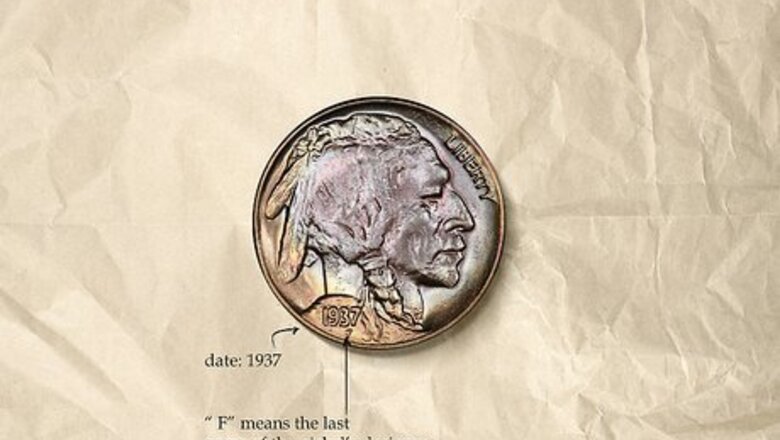
views
- To find the value of your Buffalo nickel, find the date on the man’s shoulder and the mintmark underneath the words “FIVE CENTS.”
- If your coin is in mint condition, it may be worth more than if most of the detail on the coin has been worn away. Any minting mistakes can also increase its value.
- Once you see the date, mintmark, condition, and any minting mistakes, refer to this value chart to see how much your coin is worth.
Finding the Value of a Buffalo Nickel
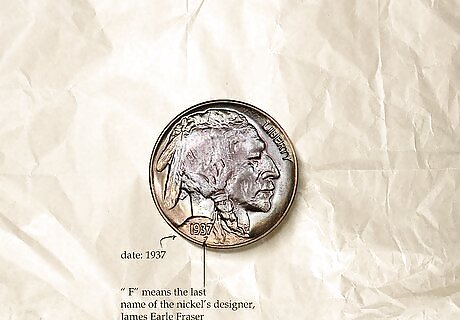
Look at the date on the Native American man’s shoulder. One side of a Buffalo nickel has the profile of a Native American man with the word “LIBERTY” along the upper edge of the coin and the date the coin was minted below the man’s neck on his shoulder. The date can influence the value of your coin depending on how many Buffalo nickels were made that year. 3 different Native American chiefs who performed in Wild West shows in New York City modeled for the design of this coin in the early 1900s—Chief Iron Tail, Chief Big Tree, and Chief Two Moons. The letter “F” is also etched underneath where the date should be located. This “F” refers to the last name of the nickel’s designer, James Earle Fraser. All Buffalo nickels are made out of 75% copper and 25% nickel. Each one is 21.2 mm in diameter and weighs 5.00 g.
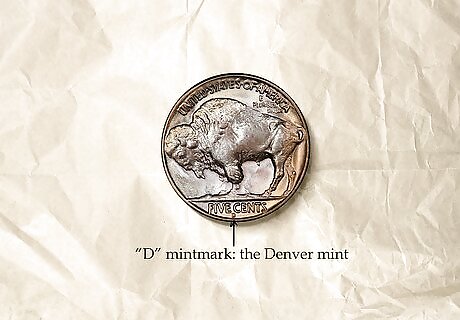
Examine the mintmark underneath the “FIVE CENTS” demarcation. Mintmarks are letters that identify where the coin was made. Collectors tend to look for all 3 mint productions for each year—this means that some coins are more valuable if there were less coins produced with a certain year and mintmark. Look under the words “FIVE CENTS” to read your coin’s mint mark. “S” mintmark: the San Francisco mint “D” mintmark: the Denver mint No mintmark: the Philadelphia mint Some people might add a mintmark to a rare coin to increase its value, so make sure a reputable coin dealer authenticates it before you purchase it.
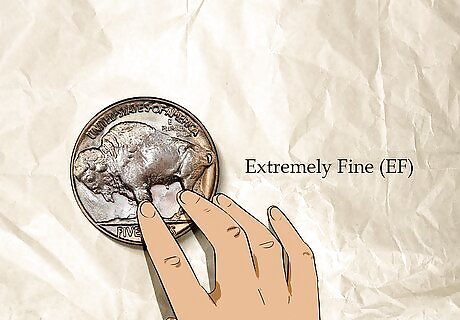
Examine the details of the coin to figure out its condition grade. Finding the condition of your coin can help you evaluate how much your coin is worth. A mint state means that the coin is in top condition, while a Fair state means that most of the details have worn away, but the date and the outlines of the man and the buffalo are still visible. Here’s how to tell the condition of your coin: Mint (MS-AU): There’s virtually no wear to the surface of the coin. The highest points of the coin (the area under the man’s eye and the upper shoulder of the buffalo where the fur meets the back) are intact with only a trace of friction. Extremely Fine (EF): All digits in the date are clear and fully raised. You can clearly see the strands of man’s hair and the outline of his feathers. The majority of the buffalo’s horn is visible, and a distinct line separates the buffalo’s back with the line of fur along their upper front leg. Fine (F-VF): All digits are visible and each number is complete and separate from the others. The man’s feather begins to merge with his head. The letters in “LIBERTY” are faint and almost touch the rim of the coin. The upper half of the buffalo’s horn is missing but the base is visible. Fair to Good (FR-VG): The date is readable but very faint. “LIBERTY” is readable but fully connected to the rim of the coin. The buffalo is missing the majority of his horn and all fur detail is one flat area. The coin has a visible outline of the Native American man and the buffalo.
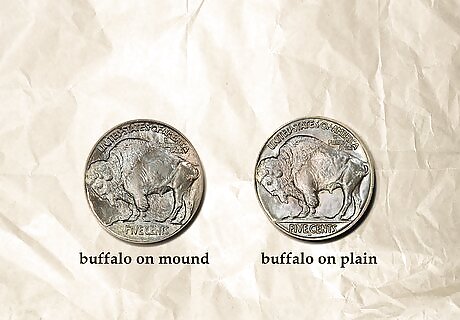
Look at the mound of earth under the date if your coin is from 1913. Buffalo nickels minted in 1913 fall into 2 types. Type 1 has “FIVE CENTS” written on top of the mound that the buffalo stands on top of, while Type 2 has the words in a space below the mound. In general, 1913 Type 2 Buffalo nickels minted in Denver or San Francisco tend to be more valuable. The Buffalo nickel originally had “FIVE CENTS” on top of the mound, but when the U.S. Mint noticed that the words wore away after because they were raised, they changed the design.
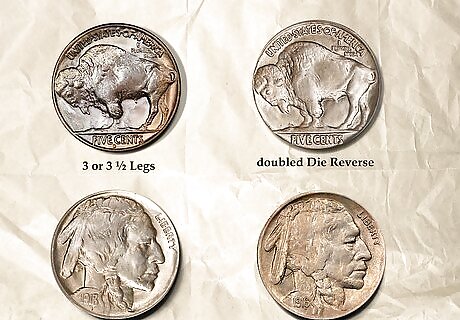
Look for minting mistakes that may make your coin stand out. Most error coins are recycled before they ever leave the mint, so those that make it into circulation are often collectible and may be incredibly valuable depending on the date it was produced. Here are some of the most common minting errors that could increase the value of your Buffalo nickel: 3 or 3 ½ Legs: The buffalo is missing its right front leg. Doubled Die Reverse: The buffalo side of the coin has been struck by the production die twice. The easiest way to identify this is by seeing if the letters in “FIVE CENTS” are doubled. 8 Over 7: The “8” in the date “1918” has been clearly stamped over the number “7.” 4 Over 3: The “4” in the date “1914” has been stamped over the number “3.” Look for a curve just to the right of the top of the 4 and a doubling in the other numbers.
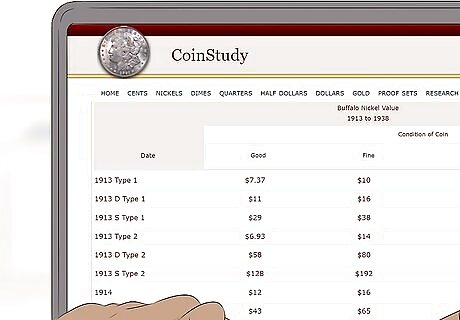
Refer to a Buffalo nickel value chart to estimate your coin’s value. Knowing the year of the coin, the mintmark, the coin’s condition, and if there are any minting errors can help you estimate how much your coin may be worth. To find the value of your Buffalo nickel, refer to this updated value chart. The numbers on the chart refer to the year, while the letter refers to the mintmark (S for San Francisco, D for Denver, and P or no date for Philadelphia). “Obverse” refers to the side of the coin with the Native American, while “reverse” refers to the side with the buffalo.
Most Valuable Buffalo Nickels

The most valuable nickels are generally misprints in mint condition. Today, almost all error coins are recycled before they ever leave the mint. However, the few that do make it into circulation can be highly collectible and valuable. The rarest and most valuable Buffalo nickels include: 1918-D 8 over 7: $37,000 to $350,750 1926 S: $12,000 to $322,000 1916-P Doubled Die Obverse: $66,000 to $281,750. 1913-D Type 2: $143,750 1935-P Doubled Die Reverse: $5,700 to $104,650 1937-D 3 Legs: $2,700 to $99,875 1921-S: $1,765 to $51,750 1936-D 3 1/2 legs: $16,000 to $21,000 1926-S: $5,000 to $10,000 1914-P 4 over 3: $3,000 to $7,000 1924-S: $2,500 to $4,000 1918-S: $640 to $3,000
Valuing a Buffalo Nickel Without a Date

Use a single bright light to find the last two digits of the coin. If you have a coin without a clear date, it may help to use a bright light and slowly adjust the angle of the coin until you can identify a faint digit or two. The “19” portion of the date often wears away first, leaving impressions of the last two digits, which can tell you the date of your coin. If the coin has the words “FIVE CENTS” on top of the mound that the buffalo stands on, your nickel is most likely a Type I from 1913. Try to avoid using ferric chloride to restore the date. Not only can this chemical ruin the appearance of the nickel, but most numismatists (coin collectors) won’t trust a date that has been brought back with ferric chloride because it can be tampered with. Without a clear date, the quality of a Buffalo nickel may fall below Good condition and value, making it worth at least $0.20.
American Buffalo Gold and Commemorative Coins
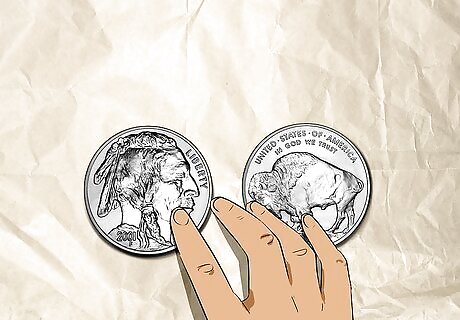
The United States released new Buffalo nickel editions in 2001 and 2006. The 2001 American Buffalo Commemorative silver coin was released commemorating the opening of the National Museum of the American Indian. The 2006 American Buffalo Gold Bullion Coins were the first 0.9999 24-karat gold coins struck by the mint and are only distributed by authorized purchasers. 2001 American Buffalo Commemorative silver coins are worth about $300 in mint condition. 2006 American Buffalo Gold Bullion coins are worth about $2,285 in mint condition. The 2005 American Bison Nickel was one of 4 coins in the Westward Journey Nickel Series commemorating the Louisiana Purchase and the Lewis and Clark expedition. Today, these Jefferson bison nickels are worth $0.40 to $1.46 in mint condition.












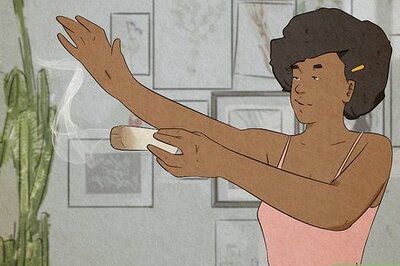



Comments
0 comment